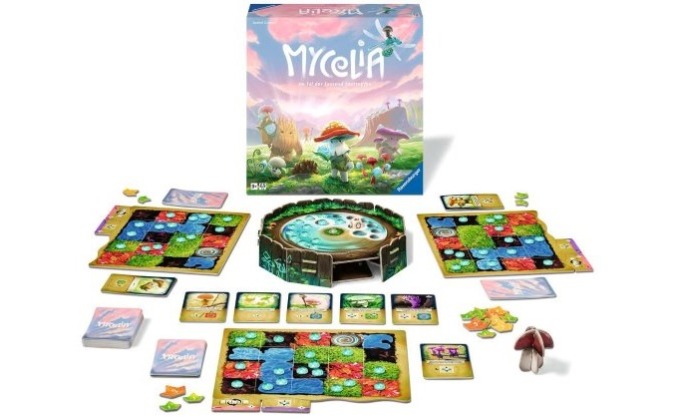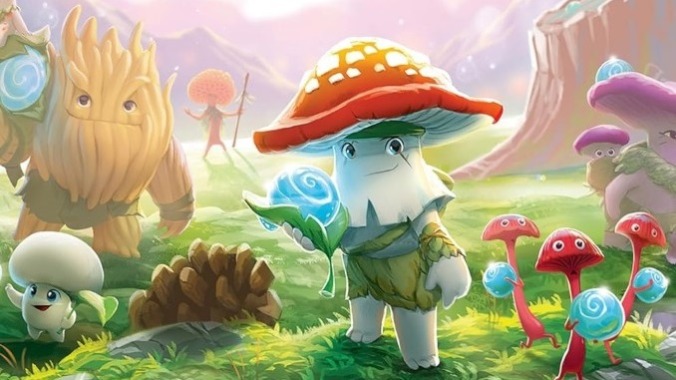Mycelia is a game of forest fungi and deckbuilding, with a friendlier vibe than a lot of deckbuilding games. You might say it gives younger players a … spore-ting chance. (Or not.)
Turns in Mycelia are incredibly simple: you draw a hand of three cards from your deck, execute all three cards in any order you’d like, and then buy one or more new cards from the market if you have enough currency to do so. The card actions use a limited set of icons that is easy to grasp, with a helpful guide to all of the icons that takes less than two pages of the rulebook even with accompanying text. You take turns until one player removes the last of the dewdrop tokens from their board, after which you complete the round and the game ends; the winner is the player who emptied their board, or, if there’s a tie, it’s the player who has the most currency remaining.
Mycelia is a very gentle deckbuilder, especially in the basic game, where there is no mechanism to remove cards from your deck—your deck just gets bigger, and the weak starter cards remain in your deck for the remainder of the game. The extended game adds hand cards and action tiles that allow you to trash cards entirely, which tends towards a more cutthroat style of play (think the Chapel strategy if you’re familiar with the original Dominion card set), since the six starter cards are underpowered compared to anything you’ll buy during the game itself, although even here you aren’t doing much to or with your opponents. Cards that involve other players give them something rather than taking away, which makes the game pretty friendly overall and means the only real player interaction is the competition to buy certain cards when they appear in the market.

In Mycelia, you’re building that deck with a single goal in mind: removing all of the dewdrop tokens from your personal board before anyone else does. You do this mostly by way of hand cards that allow you to either move dewdrops one space at a time towards your Shrine space, from which you take the tokens and put them on the main contraption that I’ll get back to in a moment; or to remove dewdrops from their current spaces directly to that contraption. You start the game with 20 dewdrops on your board, but every time the contraption is full, which depends on the player count, you turn its wheel to roll a die and drop all of the tokens out… yeah, I’ll get to it, hang on… after which every player gains one or two dewdrop tokens to put on their board. Cards that don’t move dewdrops typically give you leaf tokens, which are the currency you’ll use to buy more cards. No cards are bad or useless, but some are more expensive and thus more powerful, while there’s also some synergy between cards that should inform some of your card-buying as well as your actions on your board—you might get several cards that let you remove tokens from blue (water) spaces, and thus use other cards to move tokens on to those blue spaces in expectation of drawing one of the removal cards.
The contraption, which is the actual Shrine in the game, is both a great eye-catching feature and totally unnecessary for the game. It’s also a bit of a pain to assemble, although you just have to do that once, so that’s not really a point against the game. There is just no reason for it to exist: It would be just as easy to count the dewdrops players have removed, or maybe just place them on a flat board with spaces to count them, so you know when it’s time to roll the die and hand out new dewdrop tokens. Instead, there’s a dial with spaces on it in which you placed removed dewdrops, and when the dial is full, you turn it completely around so the die and all tokens fall down a little slide onto the table. Then you just take all of the unused dewdrops away. I understand why the design includes this feature, but I’m not that enamored of cool-looking designs if they aren’t also functional. Wingspan’s little cardboard dice-rolling birdhouse and tray look cool, but it also works for rolling five dice at once better than just doing it manually, especially since it corrals the dice so they don’t roll on to someone’s board.
The art in the game is incredibly cute, reminiscent of Kodama and Everdell with its drawings of happy little mushrooms, and it also makes everything quite distinct, such as the different terrain areas on your board. (I think they’d be fine for players who have a color vision deficiency because the terrains have different designs as well, but I’m not certain.) Play time runs from about 35-40 minutes for two players to about an hour for four, although I could see turns speeding up as players get to know the cards more and can target certain ones to buy, and the game’s recommended age range of 9 and up would be fine for the basic game—and it’d be a great way to introduce the idea of a deckbuilding game to younger players, since it’s so mild and doesn’t have a take-that element. It’s a solid family game, even if the frippery of the Shrine is so over the top.
Keith Law is the author of The Inside Game and Smart Baseball and a senior baseball writer for The Athletic. You can find his personal blog the dish, covering games, literature, and more, at meadowparty.com/blog.

